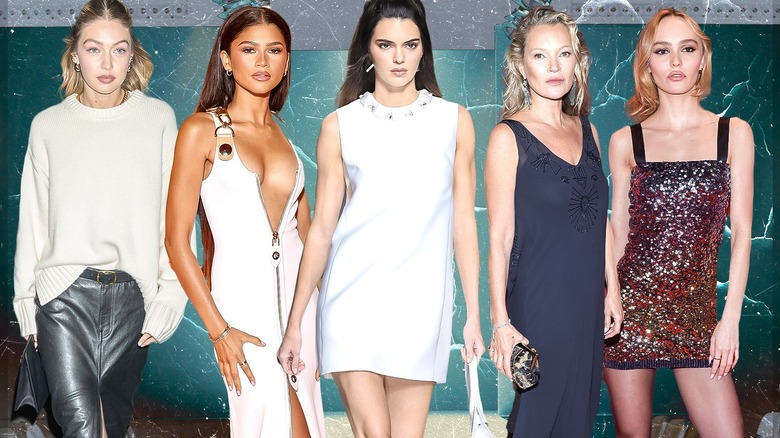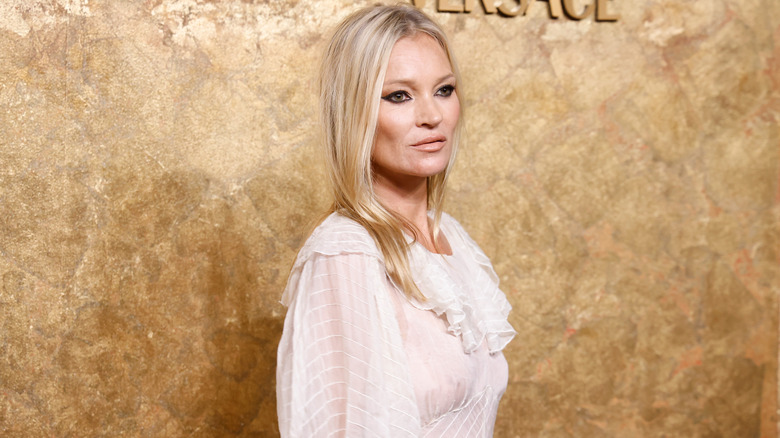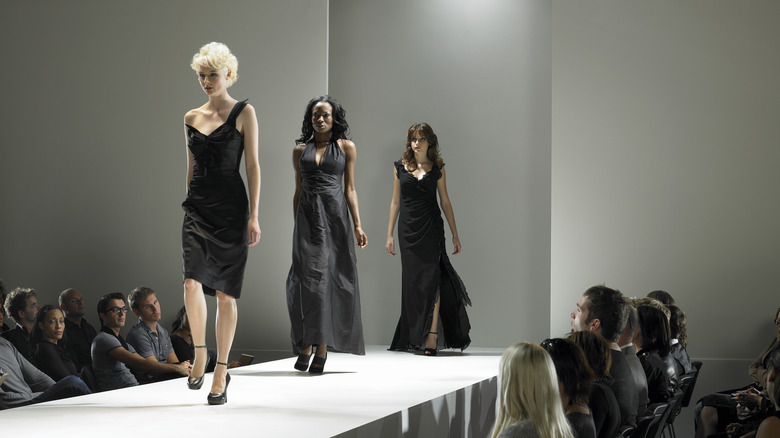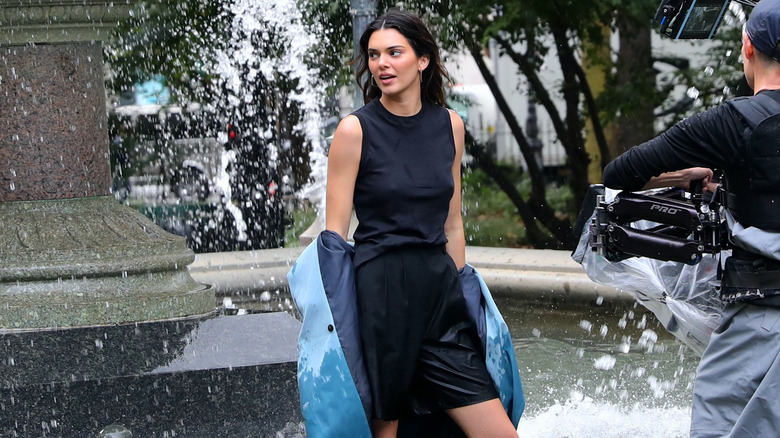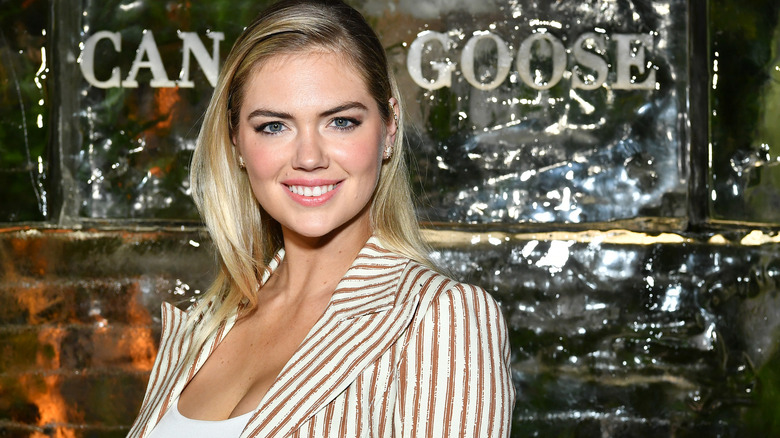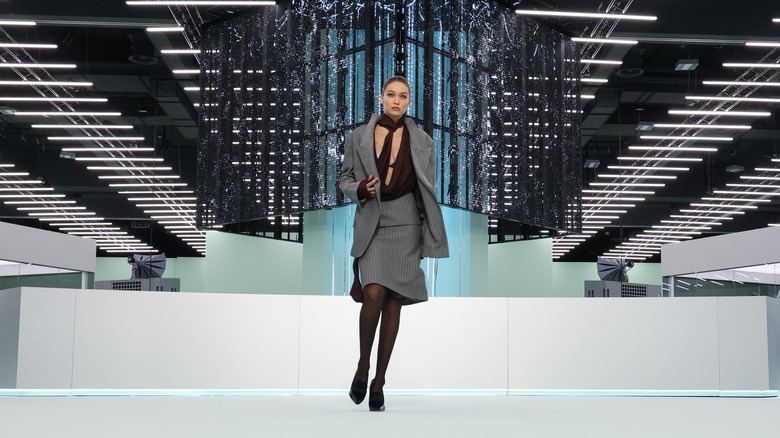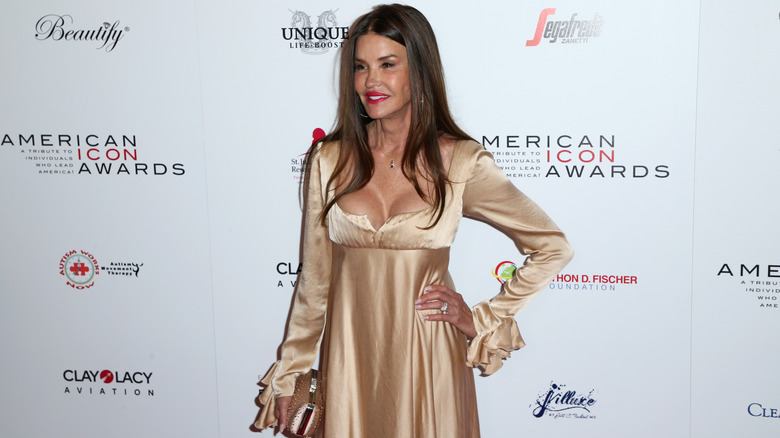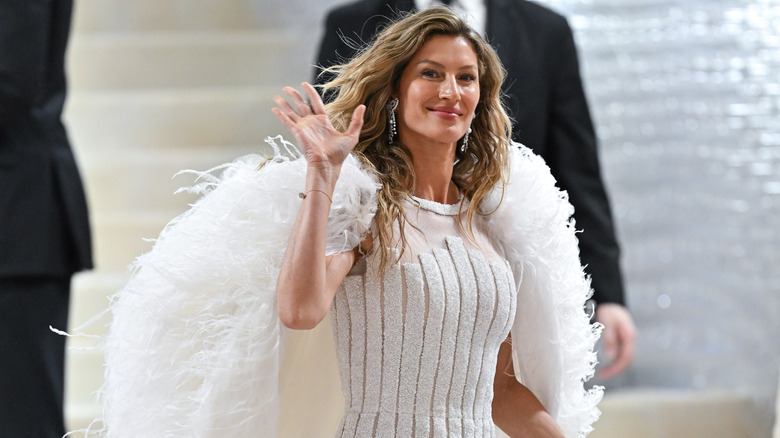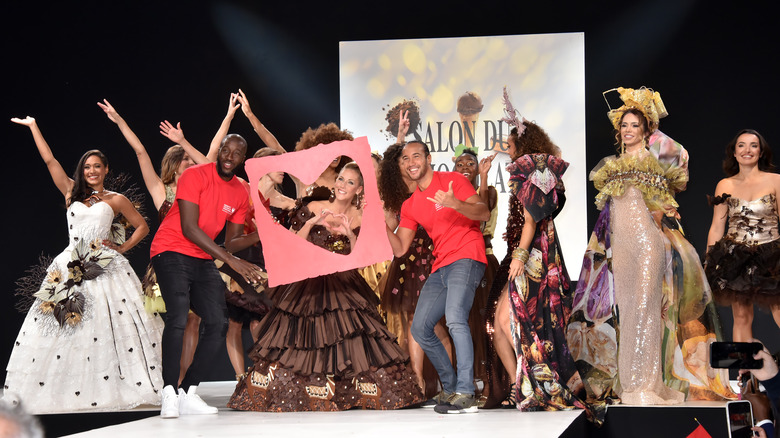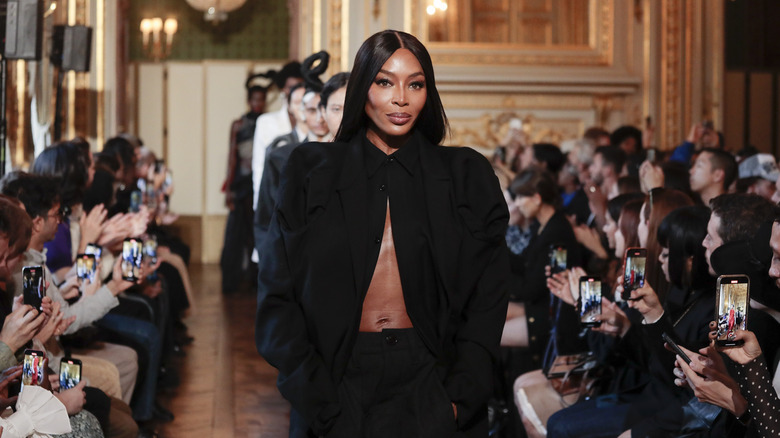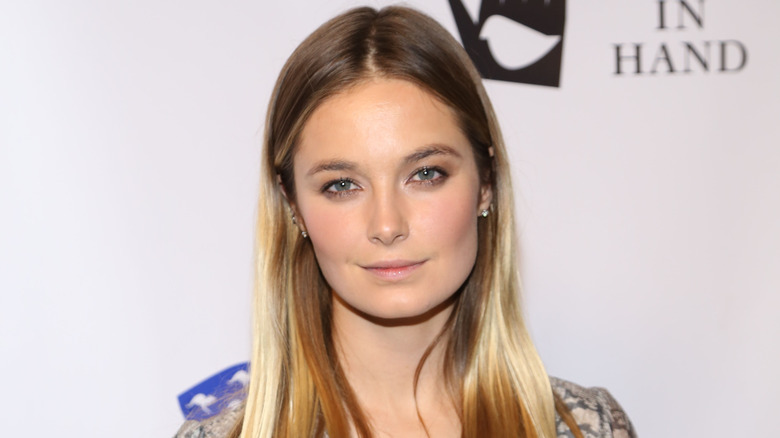The Dark Side Of Modeling
To most folks on the outside, modeling looks like a glamorous world of free clothing, fantastic hair and makeup, and the chance to schmooze with the rich and famous. However, if you've ever watched even one episode of "America's Next Top Model," you've seen some of the stresses models face — from long hours, ill-fitting clothing, and varied shooting locations to early mornings and last-minute shoots. Of course, knowing that in the early days of "America's Next Top Model," all the models were fairly new to the biz, you may think that it was just their naivete that made for stress and poor conditions, but even the most noted models have had struggles with their chosen career.
Kate Moss is a big name in the world of modeling, and she has her own experiences with the dark side of modeling. She explained to Newsweek, "I had a horrible experience with a bra catalog." Other big-name models have had experience with harassment as well. There are also cases of grueling hours for young models, not getting anything to eat or drink on shoots, and other instances where a model's life could be in jeopardy, no matter their age. So, let's take a deep dive into some of the darker corners of this career and the models who have survived to talk about it.
Lax labor laws
When it comes to child modeling, there weren't a lot of rules in place, especially when Kate Moss got her start. In that experience she told Newsweek about, she said, "I was only 15 and [the male photographer] said, 'take your top off' and I was really shy and I could feel there was something wrong and I got my stuff and ran away." This incident definitely could have led to some awful harassment for the young model had she stuck around, but there have been plenty who didn't walk out. Lily Soleil Correa Lewites, a model from San Diego, told Newsweek in that same article about her experience alone with two male photographers, saying, "It wasn't full nudity or anything like that, but for someone who wasn't even 18 yet, I realized how [dangerous it was] and how much they manipulated me."
No matter the model's age, long hours are a thing. When Riley Rasmussen was just 17 and only supposed to be working 10 hours a day, she'd sometimes spend more than that on shoots, and not in the best conditions. She told Newsweek they were shooting in 90-degree weather in Panama City. "By noon, I started to feel lethargic and nauseous. When I went to put on my jeans, I noticed they couldn't get over my legs. My entire body had begun to swell. This is where my memory gets murky." She ended up in the hospital.
There's little time for wellness
With busy schedules, models often experience burnout and major illness, even landing in the hospital. If you've watched any season of "America's Next Top Modeling," you've seen at least one contestant get extremely ill, and most likely landed in the hospital. This is the reality of this business. There's more to this than the extreme work schedules, though. Models don't always have time to eat or focus on eating enough calories for the energy they'll need on the runway or on a shoot.
"Fashion people are at risk for a variety of viral syndromes because they work long hours and they move in a pack," said Dr. Robert Glatter to The New York Times. Not only are they more susceptible to spreading viruses between one another, but if they're not taking time to eat healthy meals and stay properly hydrated each day, their immune system may not have all the nutrients needed to fight off even minor illnesses like the common cold.
Overworked is an understatement
Speaking of burnout, models spend a lot of time working — especially the best ones. Kendell Jenner told Vanity Fair, "I think being overworked and being in the situation that I'm in now is kinda what set it out of control in a way." She went on to talk about her anxiety and panic attacks, exacerbated by the busy life she leads. She told the "On Purpose" podcast she felt overworked, "just because I was overwhelmed and I felt like I was saying 'yes' to everything because I felt really, really grateful and really honored to be in the position. So I was always saying 'yes' and it just took a lot out of me to the point where I just wasn't happy anymore. And so, I had to set those boundaries for myself."
And that may be how many models feel when it comes to doing too much — they do it because they love having this career, but it affects them in negative ways. However, some models don't recover from their exhaustion. The Guardian covered a story about a 14-year-old Russian model who reportedly died due to exhaustion after modeling in Shanghai Fashion Week and doing 16 different modeling jobs in two months. That may not seem like a lot, but without knowing the length and depth of the jobs, and at only 14, who knows what her body could handle?
Sexual harassment often goes unchecked in the modeling world
While sexual harassment seems to be geared more toward budding models who are just starting out, many of those fresh faces are now big names in the industry. Kate Upton came out with her story in 2018, tweeting: "It's disappointing that such an iconic women's brand Guess is still empowering Paul Marciano as their creative director #metoo." She gave an interview to Time magazine that year, fully describing her experience with Marciano, as she remembers it, and we definitely want to express a trigger warning before you read it if you've ever been sexually harassed.
One of the most shocking quotes on sexual harassment in the modeling industry came from Paulina Porizkova in talks with The New York Times. She pointed out that in the early days of her career, models were essentially groomed to just take sexual harassment as a compliment from the people they were working with. "We were renting our body and face. Your body wasn't your own," she said. Most of these incidents happened to teenage models and occurred many years ago, but they have been working on standing up and making it known that things aren't perfect in today's industry either.
Fame isn't always easy to deal with
There are many reasons fame isn't easy for everyone to deal with. While we've seen plenty of child stars falter because they're too young to deal with all that being famous throws at them, even adults have issues when they're in the constant limelight. Fame can lead to bad habits, like drug use and alcoholism. Having all of that money can lead to excessive spending and poor decisions when it comes to what to spend that money on. Plus, being plastered across magazines and billboards, being followed by cameras, and working long hours and tough jobs can all lead to extreme stress, anxiety, and so much more.
Gigi Hadid talked to Elle about what it's like being in the spotlight, saying, "There are a lot of snapshots and really quick moments where, again, there's not a lot of context given." She added that even in the short few weeks the news stays out there, it's still excruciating. Zendaya suggests therapy, as a way to deal with these stresses. The model/actor told People, "The hope is to have a career where you can be in a position, financially, to just do things you want to do because you enjoy the work and not have to worry about the other things."
Bad habits are often idolized
And speaking of those bad habits some models fall into, this happened in the case of Gia, often considered the first supermodel. Former Vogue fashion director Jade Hobson spoke about the use of obviously drug-addicted models like Gia Carangi, as stated in an article on Daily Mail: "We made them into something. We created a monster. We maybe exploited these girls." Anne of Carversville quoted model Sophie Anderton as saying, "Drugs are so accessible within the industry, and it is very difficult to steer completely clear of them."
Then, there are some models who revel in the experiences they had around the hedonistic parts of the industry, including the drugs and sex. Case in point: Janice Dickinson, who, to some, is best known for her role as a judge for many cycles of "America's Next Top Model." She told The Standard, "People ask me what it was like ... but I don't remember. We were all so high." She added, "People were walking around with coke spoons at parties. I tried everything. I was high-speed Janice. I was addicted to drugs and alcohol." For some, drugs may have been a way to keep going — for others, a way to block out the stress of this career.
Nepotism causes issues on both sides
There are many instances in life where they say it's not what you know, it's who you know. Sometimes, if you have famous parents, you may get special treatment — but there's also a big chance that the work and praise you get is of your own accord. Lily-Rose Depp is one such celeb who has come under fire for being the child of a famous couple. She has tried hard to fight being labeled a "nepo baby." Lily-Rose is the daughter of famous actor and musician Johnny Depp and French model Vanessa Paradis. Some believe that, because she is only 5'3 — which is short for a model — she has only gotten to where she is because of her life of privilege. Lily-Rose told Elle, "People are going to have preconceived ideas about you or how you got there, and I can definitely say that nothing is going to get you the part except for being right for the part."
Nepotism doesn't always get you what you want, as "America's Next Top Model" proved on the season with CoryAnne Roberts, daughter of supermodel Stephanie Roberts. CoryAnne only made it to second runner-up. Then again, that's not a bad place to be.
Modeling means traveling and not always being able to communicate
Modeling jobs aren't always in your hometown, so models spend a lot of time traveling. They don't just stay in their home country either, which can cause some problems with miscommunication at times. Imagine traveling to a country you've never been to before, to meet with people you don't know who don't speak the same language as you, but they're going to be the people directing you. Gisele Bundchen had this happen early in her career, and she told Vogue about the experience. She recalled that she couldn't speak much English yet and was wondering what she'd be wearing for the shoot. "I just pretended I understood ... And I was like, 'Is it a T-shirt or something?' No, it was this. So I started crying."
It's what she did afterward that stands out. "I was walking the whole time thinking, 'I hope my dad doesn't ever see this picture,'" she added. "That's why I have the memory of this show, all I wanted to do was leave but you know, it's one of those things that make you stronger." Rather than run, like she wanted to, she stayed — and staying likely helped push her career along.
There's a constant need for perfection
One of the toughest parts of a career in modeling is staying perfect — keeping the same weight, avoiding wrinkles, and so on. In Cycle 12 of "America's Next Top Model," Lauren "London" Levi was sent home after gaining 10 pounds during the show (there's no proof that's the specific reason she went home, but they all definitely pointed out that it hurt her in the competition).
But, for some, it's not enough. Or therapy isn't what they first think of when they get told to lose weight or that their nose is all wrong, or some other words that can crush anyone's spirit. Victoria's Secret model Bridget Malcolm wrote on her blog about her struggles with anorexia, due to her career. "I was expected to remain a hip size of 35 inches or under. My set point is at least an inch higher than that. It is just the way I am built. Some models maintain the required size effortlessly. I am not one of those girls. Former model Linda Evangelista posted on Instagram: "To my followers who have wondered why I have not been working while my peers' careers have been thriving, the reason is that I was brutally disfigured by [CoolSculpting] which did the opposite of what it promised."
The pay isn't always that great
Modeling may seem like a luxurious and well-paying career. And while some who make it to supermodel status may do pretty well in the banking department, some models live in near poverty while trying to launch their careers. Ashley Mears, model and assistant professor of sociology at Boston University, spoke with NPR about some of the models she met while being a model herself, and how the struggle to stay afloat financially was a big thing for some. "There's an enormous pile of people who are struggling to make ends meet or just getting by, that are hoping for their chance to become winners as well," she said.
Fashion Republic breaks down the estimates of what models make, as well as pointing out some of the top paid models. Even runway models, at an average of $500 a show, will need to be working a few shows a month just to eke by on bills — and if you're living in a place where the cost of living is pretty high, you'll need to do a few shows a week to survive.
There's plenty of prejudice
Yes, even in the modeling world there is prejudice. Your looks aren't everything, and if you don't have just the right look — well, that will stand in your way as well. One model noted to Cosmopolitan that even walking with too much attitude can get you turned down for a job, but also that diversity may be a problem, even though it's much needed. Another anonymous model told the magazine, "When [the designer] found out I was transgender, something no one knows about to this day, they canceled my booking; they somehow considered it a risk — that it would draw too much attention, something they thought would affect the brand negatively: A very doubtful decision, especially considering that I was [then] an unknown, new face."
Whether it's color, hair texture, gender, or weight, models are speaking out about the discrimination. "It's passive in the systemic way that being marginalized [by the] racism, fatphobia, and transphobia still exist and are so pervasive within this industry," model Paloma Elsesser told Vogue.
Rejection is real
Getting rejected for anything sucks, and in the modeling world, there's a lot of it. You may get rejected for a job for all sorts of reasons, from being too short to having the wrong look. Even Kendell Jenner has been turned down for jobs. No matter how new or old you are to the game, there's often a lot of competition out there when it comes to scoring modeling jobs. So, while you want to go in there with a good outlook, you also want to be ready for the punch to the gut that is rejection.
Bridget Malcolm wrote on her blog about her struggles with rejection due to weight. "I have been rewarded with my highest profile clients when my hips were at their smallest (33 inches)," Malcolm wrote. "And when I gained half an inch from that, I lost those clients — being told that my body did not look good enough." This is one of those cases that can lead some models down a dark path of eating disorders. Sure, there are other jobs out there, but if modeling is a dream job for someone, trying to convince them to do something else with their life can be crushing.
If you or anyone you know needs help with addiction issues or an eating disorder, or has been a victim of sexual assault, contact the relevant resources below:
- The Substance Abuse and Mental Health Services Administration website or contact SAMHSA's National Helpline at 1-800-662-HELP (4357).
-
The National Eating Disorders Association website or contact NEDA's Live Helpline at 1-800-931-2237. You can also receive 24/7 Crisis Support via text (send NEDA to 741-741).
-
The Rape, Abuse & Incest National Network website or contact RAINN's National Helpline at 1-800-656-HOPE (4673).
